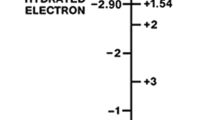Abstract
Gating current is considered to be due to the transition of dipoles, which are coupled with the membrane matrix. Based on previous theory of nerve excitation, the equation for gating current is derived; the charge displacement equation and the time constant of the gating current are also derived. Agreement with experimental data is good.
Similar content being viewed by others
Literature
Armstrong, C. M. and F. Bezanilla. 1973. “Currents Related to the Movement of the Gating Particles of the Sodium Channels.”Nature (Lond.) 242, 459–461.
—. 1974. “Charge Movement Associated with the Openings and Closing of the Activation Gates of the Na Channels.”J. Gen. Physiol.,63, 533–552.
—. 1975. “Currents Associated with the Ionic Gating Structures in Nerve Membrane.”Ann. N.Y. Acad. Sci.,264, 265–277.
Armstrong, C. M. and F. Bezanilla. 1977. “Inactivation of the Sodium Channel. II. Gating Current Experiments.”J. Gen. Physiol.,70, 567–590.
Bezanilla, F. and C. M. Armstrong 1974. “Gating Currents of the Sodium Channels: Three Ways to Block Them.”Science (Wash. D.C.),183, 753–754.
—. 1975. “Kinetic Properties and Inactivation of the Gating Currents of the Sodium Channels in Squid Axon.”Phil. Trans. R. Soc.,B270, 449.
—. 1975. “Inactivation of Gating Charge Movement.”Biophys. J.,15, 163a.
Chiang, C. 1978. “On the Nerve Impulse Equation: The Dynamic Responses of Nerve Impulse.”Bull. Math. Biol.,40, 247–255.
Goldman, L. 1976. “Kinetics of Channel Gating in Excitable Membranes.”Q. Rev. Biophys.,9, 491–526.
— and R. Hahin. 1978. “Sodium Tail Currents in Myxicola.”Biophys. J.,21, 41a.
Hodgkin, A. L. and A. F. Huxley. 1952. “A Quantitative Description of Memgrane Current and its Application to Conduction and Excitation in Nerve.”J. Physiol. (Lond.),117, 500–544.
Hodson, H. and L. Y. Wei. 1976. “Comparative Evaluation of Quantum Theory Nerve Excitation.”Bull. Math. Biol.,38, 277–293.
Keynes, R. D. 1975. “Organization of the Ionic Channels in Nerve Membranes.” InThe Nervous System, Vol. 1: Basic Neurosciences, D. B. Tower, (Ed.). New York: Raven Press.
— and E. Rojas. 1974. “Kinetics and Steady-State Properties of the Charged System Controlling Sodium Conductance in the Squid Giant Axon.”J. Physiol.,239, 393–434.
—. 1976. “The Temporal and Steady-State Relationships Between Activation of the Sodium Conductance and Movement of the Gating Particles in the Squid Giant Axon.”J. Physiol.,255, 157–189.
Keynes, R. D. and J. E. Kimura. 1977. “Opening and Closing Ionic Channels in Nerve.” International Congress. Paris, p. 194.
Lee, C. Y. and C. Chiang. 1976. “Nerve Excitation by the Coupling of Dipoles and Membrane Matrix.”Bull. Math. Biol.,38, 59–70.
Meves, H. 1974. “The Effect of Holding Potential on the Asymmetry Currents in Squid Axons.”J. Physiol.,243, 847–867.
— and W. Vogel. 1977. “Inactivation of the Asymmetrical Displacement Current in Giant Axons ofLoligo forbesi”J. Physiol.,267, 377–393.
Neumcke, B., W. Nonner and R. Stämpfli. 1976. “Asymmetrical Displacement Current and its Relation with the Activation of Sodium Current in the Membrane of Frog Myelinated Nerve.”Pflüger Arch.,363, 193–203.
Nonner, W., E. Rojas and R. Stämpfli. 1975. “Displacement Currents in the Node of Ranvier.”Pflügers Arch.,354, 1–18.
—. 1978. “Asymmetrical Displacement Currents in the Membrane of Frog Myelinated Nerve: Early Time Course and Effects of Membrane Potential.”Pflügers Arch.,375, 75–85.
Nonner, W., B. Neumcke and R. Stämpfli. 1977. “Gating Current and Activation of Na Current in Myelinated Nerve.” International Congress. Paris. p. 197.
Rojas, E. and R. D. Keynes. 1975. “On the Relation between Displacement Currents and Activation of the Sodium Conductance in the Squid Giant Axon.”Phil. Trans. R. Soc. Lond. B.,270, 459–482.
Wei, L. Y. 1969. “Molecular Mechanisms of Nerve Excitation and Conduction.”Bull. Meth. Biophys.,31, 39–58.
— 1971. “Possible Origin of Action Potential and Birefringence Change in Nerve Axon.”Bull. Math. Biophys.,33, 521–537.
— 1972. “Dipole Theory of Heat Production and Absorption in Nerve Axon.”Biophys. J.,12, 1159–1170.
Author information
Authors and Affiliations
Rights and permissions
About this article
Cite this article
Chiang, C. On the gating currents and the dipole transitions. Bltn Mathcal Biology 41, 841–848 (1979). https://doi.org/10.1007/BF02462381
Received:
Revised:
Issue Date:
DOI: https://doi.org/10.1007/BF02462381




